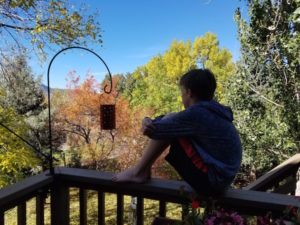by Alison Staudinger, Ph.D., University of Wisconsin – Green Bay
Like many trained in the academy, I am skeptical of “woo”– practices with trappings of scientific import, but lacking empirical evidence. This is despite my recognition that science has always been suffused by power and social hierarchy in the very framing of its questions. In my pedagogical life, this means it has taken me a long time to warm up to “mindfulness,” a powerful, relatively recent trend in education. Mindfulness is sometimes touted as the solution to many serious problems— lack of emotional constraint, student stress and even faculty burnout. Some might wonder if its popularity doesn’t merely adjust us to the difficulties of life in late capitalism, which in the classroom often appear through long days of emotional labor. But, of course, there are branches of mindfulness associated with nearly every culture and major religion on the globe, many with complex histories and practices that have clearly been important for humans long before our fears of robot overlords emerged. Still, I tend towards asking many of my students to come into more contact with the world, not less, as I feared that meditation or the like might do. Contemplation might be good for self-care, I thought— or working through one’s own “shadow self,” just like therapy, but the justice-oriented classroom requires the tools of critique and conflict. Or does it?
My above assumptions were powerfully challenged at the The Center for Contemplative Mind’s Summer Session on Contemplative Learning in August of 2017, where I spent a week exploring the “tree” of contemplative pedagogy and practice, and did more coloring and dancing than at any other academic experience to date. I want to share three important concepts that might be useful for integrating a mindful approach to metacognition into your life or classroom. Ed Nufer has already written on the focus on the “present” that mindfulness brings, and Chris Was asked us to reconsider the relationship between mindfulness and metacognition. It is my hope that these three concepts are a tiny contribution to that reconsideration, and counter the idea that mindfulness practitioners seek to move beyond the self, rather than reflect on their learning.
First, presenter Kakali Bhattacharya shared how mindfulness helps her flourish in the often hostile institutional spaces of academia. Bhattacharya uses the image of a cup overflowing, saying that you must give to others from the overflow and thus must keep your cup full. For her, mindfulness as a method of self-care was coupled with a commitment to “post-oppositional” thinking and politics. Post-oppositionality requires rejecting existing narratives that frame struggles as Machichean battles between good and evil, a move that is difficult in our partisan times. However, this ability to recognize non-absolutes in a political sense may bear dividends in an intellectual one. Drawing on this, I replaced an assignment that had students debate two contrasting positions with one where they tried to reimagine the problem, offer a variety of solutions, or response from a position of intellectual humility about their own stance. While our in-class process was messy, their ultimate papers on the topic were creative and veered away from the same two arguments I’m used to reading.
The second concept, closely related to post-oppositionality, is “negative capability,” an idea taken from John Keats’ correspondence but now popular in psychology and business. Negative capacity names the ability to tolerate uncertainty, or, as Keats says, to be “capable of being in uncertainties, mysteries, doubts, without any irritable reach after fact and reason……”. (Cite Research). This might seem initially a strange concept to link to metacognition— it seems initially to involve not thinking about thinking, or, rather, willingly allowing yourself to think two contradictory things or to dwell in a lack of knowledge or understanding. For Keats, this is a process of imagination preferable to that of thinking, in the technical sense. Keats, as a Romantic, is generally understood as a critic of reason and fan of feeling. His poetic practice involves inhabiting the minds of his characters and even objects; he wrote that he could imagine a billiard ball enjoying “its own roundness, smoothness, volubility and the rapidity of its motion.” Cultivating these spaces of flow, or negative capability, might increase our ability to also reflect on our own learning and thinking, even as we, in those moments, refrain from committing to them or even to our own identity. Certainly an exercise to explore this idea would be easy to devise— although actually inhabiting an object is harder to do. In a class on ecology, imagining oneself as a plant and perhaps writing from that perspective might open up new vistas but also encourage negative capacity as a tendency of mind.
My mindfulness experience also left me wondering about the costs of integrating some of these practices into student learning shorn of their embeddedness into spiritual or cultural traditions, which brings me to the third concept— of avoiding treating mindfulness as a mere means to an end. Meditation is central to buddhism, but also to a variety of indigenous spiritual practices, and I wondered if they would work without this framework. Were they turned into, as one presenter worried, “McMindfulness” practices? One person I met was passionate about the notion that in meditation there is “No path, no wisdom, no gain” — a radical de-instrumentalization of the practice. To fully understand this saying would take a great deal of meditation, but I began to recognize throughout the week that the focus on the inward development that can occur in mindful practice was, paradoxically, likely to bear more fruit if not linked to specific goals or learning objectives from the outside. This realization was very hard to think about integrating in my classrooms— as each day is driven by specific goals linked to broader course objectives. My challenge for this year is to develop the negative capacity I need in order to engage in some of these practices with my students non-instrumentally while also recognizing the benefits research has shown for improving learning, happiness and health. And, I may need a commitment to post-oppositionality to navigate barriers to “woo” in some academic cultures.





